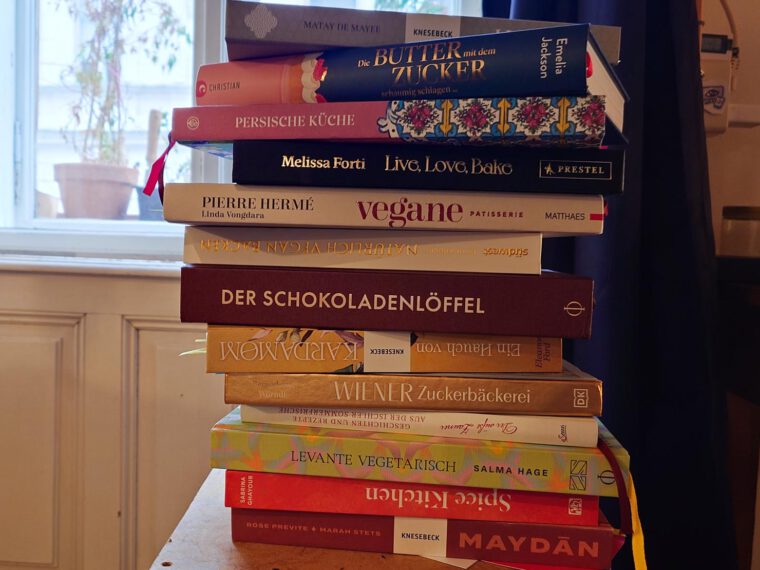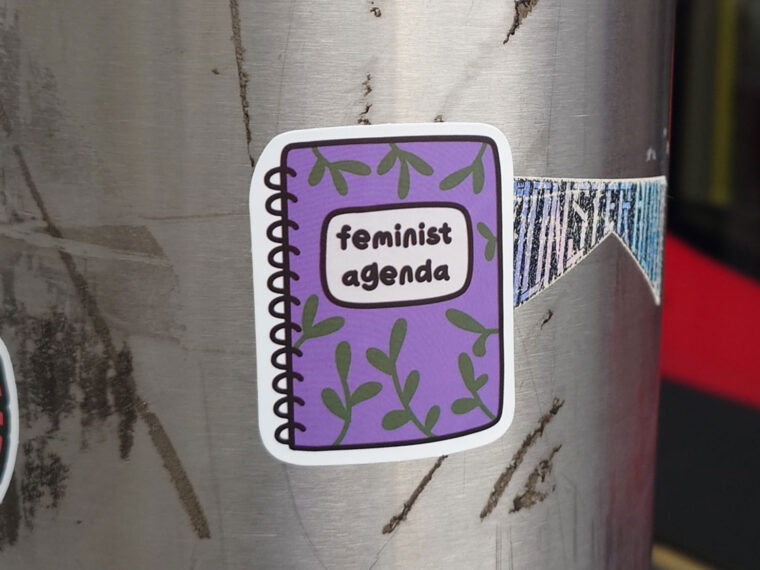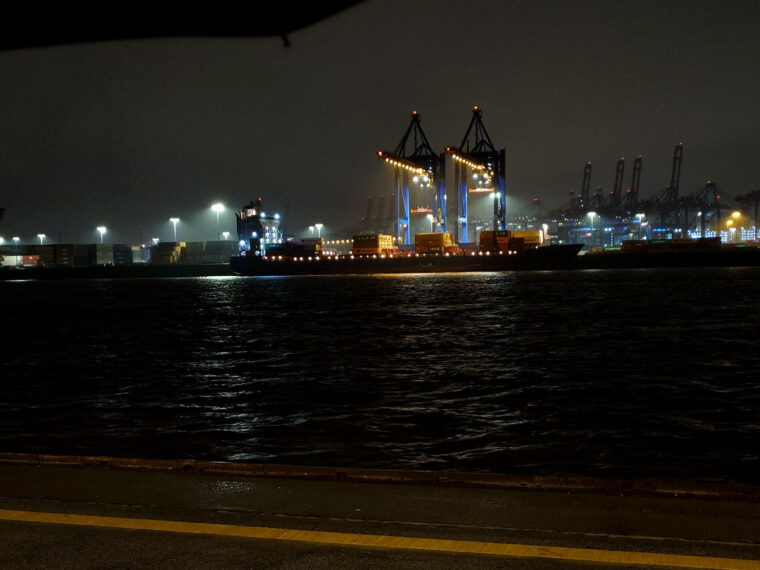
…mit kaum Gebackenem, viel wildem Grünzeug, einem Näh- und einem Strickprojekt – und wie immer, den besten Links der letzten Wochen.
Seit dem letzen Zuckersüß habe ich Rührkuchen mit Kirsch- und Duftgeranienblättern gebacken. Proof of concept, aber verbesserungswürdig. Außerdem Chocolate Chip Cookies (Rezept von 2017) mit sämtlichen Schoko-Osterhasen/Weihnachtsmännern/Werbegeschenken, die ich gerade zur Hand hatte.
Gegessen
Junge Weintriebe (die schmecken so gut! muss mir noch was anderes damit einfallen lassen), Lindenblätter und Brennnessel, in etwa zubereitet wie masak lemak (SeriousEats), was nicht sehr überzeugend war. In Bierteig gebackene Holler- und Rosenblüten, getunkt in frisch gekochten Rosensirup, sehr gut. Pizza. Ein Karotten-Tofu-Curry mit Kokos. Spaghetti mit Tomatensauce und Fake-Meatballs.
Je eine Kugel Matcha- und Orangenmarmeladeeis (5,20€?!) von Gefrorenes (1180). Tteok von Ko:on (1010), das bisher mein liebster Snack der Kategorie „günstiges Innenstadt-Streetfood“ war, aber jetzt statt 2€ auf einmal 3,50€ kostet. Ganz okaye Takeout Jiao Zi mit Shiitake-Glasnudel-Füllung (12,90€) von Edo (1180).
Gestrickt/genäht
Weiter am Drawstring Camisole (Purl Soho) gestrickt und am Second-Hand-Änderungskleid genäht.
Veröffentlicht
Im Blog: Popcorn Cocktail, „Babel“ – R.F. Kuang, „Ein schönes Ausländerkind“ – Toxische Pommes
Anderswo: #14 Ein dreifacher Axel ins Tor – mit Manuela Zinsberger von Jeannes Varieté, dem Podcast meiner Chefin Jeanne Drach, den ich mitkonzipiert habe und laufend mitproduziere, wo es ums Eislaufen, Fahrradfahren und Fußballspielen geht.
Hier folgen meine liebsten Links der letzten Woche:
Rezepte
Pappa al Pomodoro – Effilee
Das hatte ich ja vor ein paar Wochen in Florenz zum ersten Mal gegessen (s. Zuckersüß 471), jetzt ist mir ein Rezept für die Weißbrot-Tomaten-„Suppe“ entgegengeflattert.
Leche de Pantera Cocktail Recipe | PUNCH
Kondensmilch im Cocktail, hm.
Texte
The Feast of Saint John – The Fence (via Web curios)
Sehr gut geschriebener Text über ein Praktikum im Londoner Spitzenrestaurant St John:
The next few days were a blur of flesh, fat and oil spent by the butcher’s block making terrines, blood cakes and whatever else Fergus had dreamed up as appropriate food for that time of year. Things started with kidneys and quickly moved onto gutting woodcock and pigeon, then sifting through pigs’ trotters slowly cooked in a mixture of stock and white wine. They called it ‘Trotter Gear’ at St. JOHN and loved adding it to any unsuspecting veg that needed a bit of sprucing up. It was delicious, if disconcerting, because while sifting through the ligaments you had to keep an eye out for nail fragments which, although invisible to the naked eye, were easy to find by hand because they felt exactly the same as those on the end of your fingers. But I hadn’t got around to thinking that way just yet. One second I would be coaxing 50 lambs’ testicles out of their two different casings to reveal a ball of spongy flesh that resembled an amoeba under a microscope; the next, I was hacking chunks of tripe apart, dredging, then breading them for the fryer to be served with homemade ketchup
In Defense of Eating Brains – Gastro Obscura (via Web curios)
Ich wusste nicht, dass Gehirn als Zutat sich genauso verhält wie Eigelb:
Yet for many in the modern United States, there’s something uniquely unpalatable about eating brains, a squeamishness that goes back only a few generations. Before the mid-20th century, Americans treated the brain like any other cut of meat, especially in areas where livestock animals were raised. At least one company, Rose, still markets canned brains soaked in milk (a typical initial step when preparing brains to remove the blood). Scrambled eggs and brains was once a classic American breakfast pairing, appearing in Fannie Farmer’s influential 1896 cookbook and many others. “When [brain] is lightly cooked and pan-fried, it has a very similar texture to scrambled egg,” says VanHouten, who included a recipe for the dish in her own cookbook, It Takes Guts. “Mixed together, you barely even taste [the brain]. It’s just adding a little bit of richness to your eggs.” Farzin points out that you can use brains the same way as egg yolks; even in custard-based ice cream or an emulsified “brainaise.”
A Single Dish a Thousand Times: On Rebecca May Johnson’s “Small Fires” | Los Angeles Review of Books (via Alicia Kennedy)
Dieses Buch hat mich ENORM begeistert, aber ich habe nie drüber geschrieben und jetzt muss ichs glaub ich nochmal lesen. In dieser Rezension geht es aber um recipe/food-writing allgemein.
Plenty of books interweave food directions with a fictional or nonfictional record, certainly. Plenty invite such interweaving. But this can’t be the only way to take recipes seriously. In an essay about the stakes of culinary writing, Delores B. Phillips wonders whether, in the rush to narrativize cookbooks, we assume too easily that a proper appreciation requires narrativization. Do we need cooking stories? When it comes to recipes, it seems, many of us read Playboy for the articles. So, what are we denying, overcoming, or ignoring when we do?
Eine Studie in Scharlachrot – Jonathan Yeos HM King Charles III – 54books
Über das neue britische Königsporträt:
Nach Fotos zu malen ist eigentlich eine übliche Praxis in der Porträtmalerei, besonders bei Porträts von Menschen mit sehr engen Terminkalendern. Dass Yeo darauf bestehen kann, dass selbst ein Wirtschaftsmagnat wie Rupert Murdoch oder eben der König für ihn tatsächlich „sitzt“, zeigt seinen Status. Yeo wird nicht als Dienstleister engagiert, sondern er ist der Künstler, dessen ästhetischer Kompetenz sich der Machtmensch unterordnet. Damit sich die Nachwelt an eine Person erinnern wird, die mehr war als einfach nur sehr reich oder mächtig oder, wie im Fall der vielen Filmstars, die Yeo bereits gemalt hat, sehr gutaussehend. (Sehr interessant ist die Differenz in den Stilen, die Yeo für seine weiblichen Star- oder Modell-Porträts nutzt, und die Art, wie er alle Männer und die Frauen malt, deren Beruf nicht das Angeschaut-werden ist. Die weiblichen Stars malt er in einem ganz ähnlichen Stil wie die Frauen in seiner Plastic Surgery-Serie. Anschauen kann man sich Yeos Bilder hier.
Press Pause on the Silicon Valley Hype Machine – The New York Times (via Dave Karpf)
Mir war nicht aufgefallen, dass die „wir-brauchen-eine-6-Monats-AI-Entwicklungspause“-Diskussion schon ein Jahr her ist. Julia Angwin:
It feels like another sign that A.I. is not even close to living up to its hype. In my eyes, it’s looking less like an all-powerful being and more like a bad intern whose work is so unreliable that it’s often easier to do the task yourself. That realization has real implications for the way we, our employers and our government should deal with Silicon Valley’s latest dazzling new, new thing. Acknowledging A.I.’s flaws could help us invest our resources more efficiently and also allow us to turn our attention toward more realistic solutions.
The Toilet Theory of the Internet – The Atlantic (via Internet Observatorium)
Charlie Warzel über die neuesten ~Innovationen~ der Google Suche (ich persönlich find sie furchtbar, ich will nämlich genau wissen, woher meine Information kommt und verlasse mich bei einer Frage höchst selten auf ein einzelnes Suchergebnis).
People use Google to find information in a pinch—the average Googler looks less like an opposition researcher or a librarian and more like a concerned parent typing barely comprehensible phrases into their phone’s browser, along the lines of milk bird flu safe? Some people might spend a lot of time going as deep as possible, picking through search results to compare information. But one recent analysis shows that most people visit just one page when they Google; that same analysis found that about half of all search sessions are finished in less than a minute. For this reason, it’s in the company’s best interest to make using the site as quick and frictionless as possible.
Google’s broken link to the web – Platformer (via CJ Chilvers)
Casey Newton ist noch skeptischer/pessimistischer:
As I noted when I wrote about the new, more extractive search engines from companies like Arc and Brave, Google’s move to answer more questions on the search engine results page is simply a continuation of a long-standing practice. But where the company once limited itself to gathering low-hanging fruit along the lines of “what time is the super bowl,” on Tuesday executives showcased generative AI tools that will someday plan an entire anniversary dinner, or cross-country-move, or trip abroad. A quarter-century into its existence, a company that once proudly served as an entry point to a web that it nourished with traffic and advertising revenue has begun to abstract that all away into an input for its large language models.
This new approach is captured elegantly in a slogan that appeared several times during Tuesday’s keynote: let Google do the Googling for you. It’s a phrase that identifies browsing the web — a task once considered entertaining enough that it was given the nickname “surfing” — as a chore, something better left to a bot.
Chat box? No thanks 🙅 – Design Lobster (via Gregor Schmalzried)
AI zur Abwechslung mal aus UI-Perspektive. Wobei ich die Idee von „recipe editors“ als nicht sehr erfolgreich einschätze, jedenfalls wenn die dahinterliegende AI mit so schrottigen Rezepten gefüllt wird, die den Großteil des Webs ausmachen… Dieser Newsletter scheint btw auch auf viel Spannendes zu verlinken, gleich mal (per RSS, natürlich) abonniert.
LLMs make it possible for a computer to see and understand what is in front of it and then use the internet to conjure up more information about that topic. In January this year, Google wrapped this ability into a neat design pattern where you can use your finger to circle anything on your screen to learn more about it. This collision of direct manipulation and world understanding unlocks all sorts of exciting design possibilities. It now feels like anything we see on a screen should behave like a hyperlink, a portal into more knowledge, understanding and detail.
The Sound of Software | !Boring (via Design Lobster)
Mehr UI, hier an der Schnittstelle zu Sounddesign:
Create tangibility. Software design is something of a magic trick. That trick is to fool you into believing our software isn’t just a grid of pixels lighting up on a screen. It’s a tangible tray, a hovering popup, a blobby button. Sound, like drop shadows or overshoot animations, can add a sense of materiality to an interface. Think of the crumpling paper sound when you trash a file on macOS. The sound makes the action tangible and gives it more weight when in reality the computer is simply changing a few bits. In spatial design, sound is even more critical when other tactile senses like haptics are lost.
I Went Undercover as a Secret OnlyFans Chatter. It Wasn’t Pretty | WIRED (via Links I Would GChat You)
Oh, das Internet. Gig-/Clickwork für OnlyFans-Stars hat *überraschenderweise* super schlechte Arbeitsbedingungen. Der Text ist allerdings trotz des unerfreulichen Themas ziemlich lustig, weil der Autor nämlich kurzzeitig versucht, Karriere als OnlyFans-Chatter zu machen.
To seal the deal, I needed to pass an elaborate written test. Daniel sent me a biographical sketch for a fictional “adult influencer from Tokyo” named Miko; she was a fan of karate, green tea, and the tongue emoji. My assignment was to write four extended back-and-forth dialogs between Miko and a hypothetical subscriber—two had to involve X-rated material, while the other two were meant to be clean. “Each bot’s reply should contain a call to action, a question, a compliment, or an inspiration to do something,” the instructions dictated, though I was forbidden from using question marks in more than 20 percent of Miko’s responses.
A glitch in the matrix of online shopping – Links I Would GChat You
Ein anderer Aspekt von late-stage-capitalism-web:
As furniture and home goods sales have moved online, retail experts told me, more and more stores have sought a piece of the action. But instead of sourcing or creating their own products, many large retailers have relied on overlapping networks of manufacturers, distributors and third-party sellers — creating a baffling (and frankly, shady) shopping environment where many sites sell identical or near-identical items under different names and at wildly different prices.
Monument der Zehnerjahre – Der Megabeststeller „101 Essays, die dein Leben verändern werden“ – 54books
Dieser Verriss passt auch sehr gut zum Zustand des Webs, aber so, wie es bis ca. 2020 war. Das Buch habe ich neulich irgendwo liegen sehen und durchgeblättert und es ist sehr… verzichtbar.
Als Ratgeber ist 101 Essays nicht ernst zu nehmen und man kann nur vor Menschen warnen, die die darin verbreitete Ideologie allzu sehr verinnerlichen. Als Dokument seiner Zeit ist es aber an Prägnanz kaum zu überbieten. Es lässt das Bild einer verunsicherten, getriebenen Kohorte netzaffiner Twentysomethings zwischen Finanzkrise und Trump-Wahl auferstehen, denen die unvereinbaren Imperative eingebrannt worden waren, jede Minute ihres Lebens zugleich hart zu arbeiten und kreativ Einzigartiges hervorzubringen, aber alles stets gelassen, wholesome, cozy und achtsam, mit einer großen heißen Tasse Tee in beiden Händen, am Tresen der instagrammabel Joy sparkenden Minimalismusbude. Das konsequente Produkt dieser lebenszerstörenden Unmöglichkeit ist Wiests weder als Buch entstandener noch eigentlich zum Lesen gedachter Quatschwälzer voller widersprüchlicher, geschwätziger und wichtigtuerischer Ratschläge. Dass es hierzulande erst Jahre später ein Bestseller geworden ist, in einer Epoche, in der die Bedeutungslosigkeit individuellen Strebens vor dem Hintergrund gesellschaftlicher Machtformationen und weltgeschichtlicher Verwerfungen so klar zutage tritt wie seit den 80ern nicht mehr, ist bizarr, passt aber zum nachholenden Charakter vieler kultureller Entwicklungen in Deutschland.
Ten steps to the side, then a line drawing. – Anna’s Substack
Künstlerin Anna Kohlweis schreibt darüber, wie es sich für sie anfühlt, autistisch zu sein.
Suddenly having a word for having lived a life with an odd brain is like this: Imagine looking at your experiences all these years and seeing something that doesn’t make sense, an arrangement of tiny little scribbles floating in mid air, until somebody tells you that actually, your required viewpoint is ten steps to the left. You walk over there, see a mark on the floor with your name on it, look at the scribbles, and suddenly all the bits join up to form a perfectly clear line drawing. Or, imagine feeling like a failed horse for decades until somebody comes along and goes „hey, zebra“. Huh.
Audio/Video
Duft der Erinnerung – Auf den Spuren eines Parfümeur-Lehrling | ARTE
Eine sehr schöne Doku mit cuter Animation über Abdulkader Fattouh, Enkel eines Parfümeurs in Aleppo, der vor dem Krieg flieht und sich in Frankreich zum Parfümeur ausbilden lässt. Ließ mich an eine Story aus dem neuesten Cake Zine denken (s. Zuckersüß 469).
Island in Between | An Oscar-Nominated Op-Doc (via What Happened Last Week)
Ein Film über die taiwanesische Inselgruppe Kinmen, gleich vor Chinas Küste.
Sonst So
how-i-experience-web-today.com (via Gregor Schmalzried)
SO nervig.
Stash Socks – Amy Gunderson – ravelry
Restl-Socken, aber nicht gestreift!
Backkatalog:
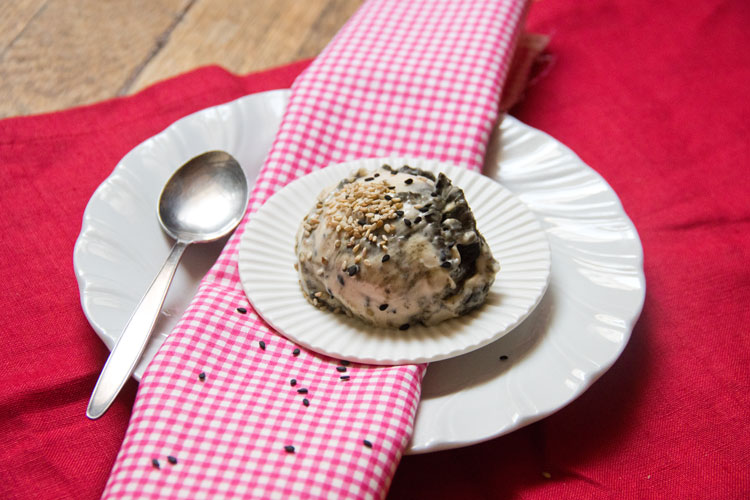


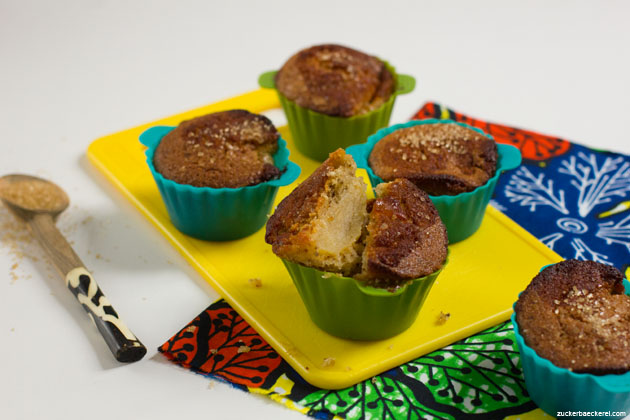
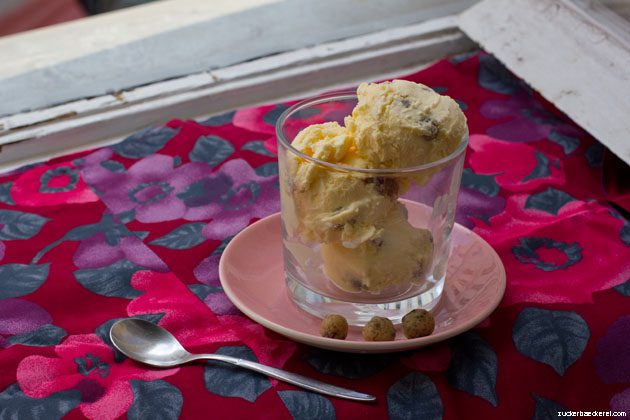
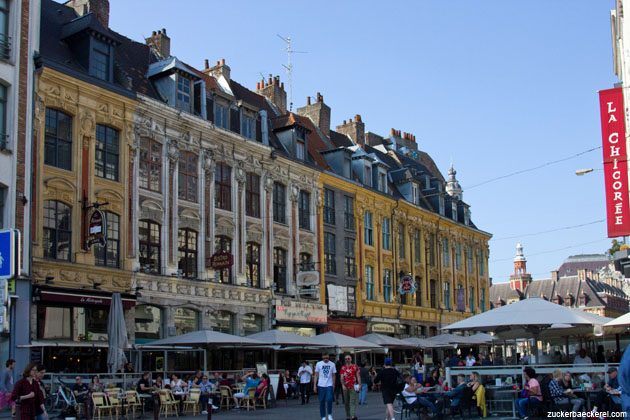
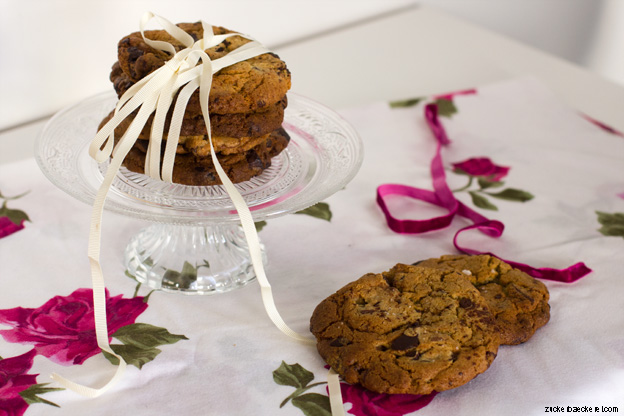
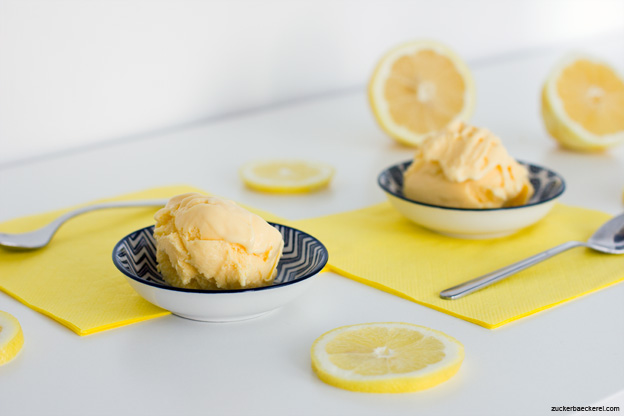
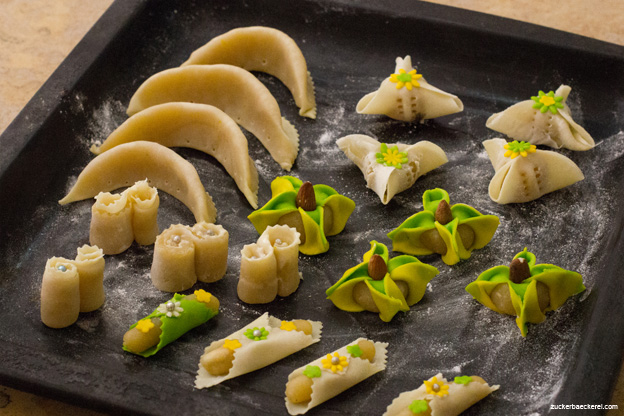
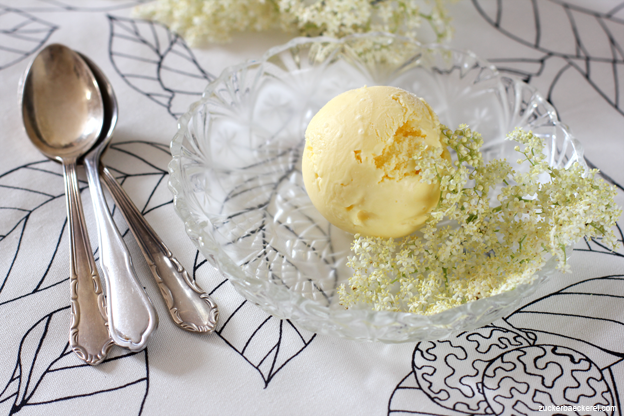
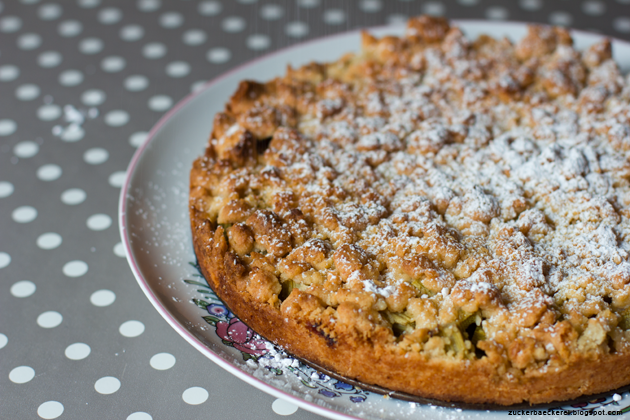
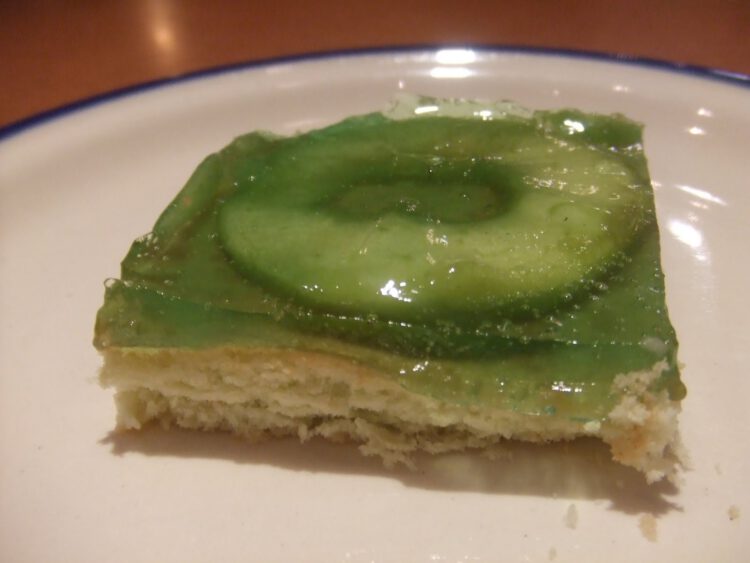


- 2023: Sesam-Eis mit schwarzem Tahini-Karamell
- 2022: „Lofthouse Style“ Cookies nach Bravetart
- 2021: Orange Sticky Buns
- 2020: Honig-Apfel-Walnuss-Muffins
- 2019: Vanilleeis mit Cookieteig
- 2018: Eine Reise nach Lille, Dunkerque und Bruxelles
- 2017: Bravetart’s Chocolate Chip Cookies
- 2016: Zitroneneis
- 2015: Corns de Gazelle – Backkurs in Essaouira
- 2014: Holunderblüteneis
- 2013: Rhabarber-Streusel-Tarte
- 2012: Waldmeister-Apfel-Kuchen
- 2011: Shortbread
- 2010: Knopfkekse

 Hi, ich bin Jana. Seit 2009 veröffentliche ich hier wöchentlich Rezepte, Reiseberichte, Restaurantempfehlungen (meistens in Wien), Linktipps und alles, was ich sonst noch spannend finde. Ich arbeite als Redakteurin bei futurezone.at, als freie Audio-/Kulinarikjournalistin und Sketchnoterin. Lies mehr über mich und die Zuckerbäckerei auf der
Hi, ich bin Jana. Seit 2009 veröffentliche ich hier wöchentlich Rezepte, Reiseberichte, Restaurantempfehlungen (meistens in Wien), Linktipps und alles, was ich sonst noch spannend finde. Ich arbeite als Redakteurin bei futurezone.at, als freie Audio-/Kulinarikjournalistin und Sketchnoterin. Lies mehr über mich und die Zuckerbäckerei auf der 

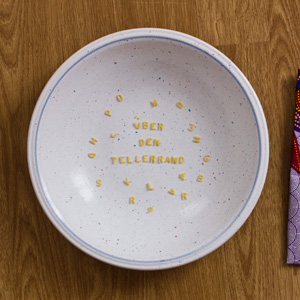 Über den Tellerrand
Über den Tellerrand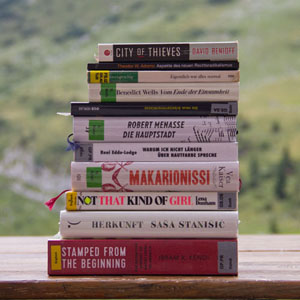 Bücher
Bücher Zuckersüß
Zuckersüß